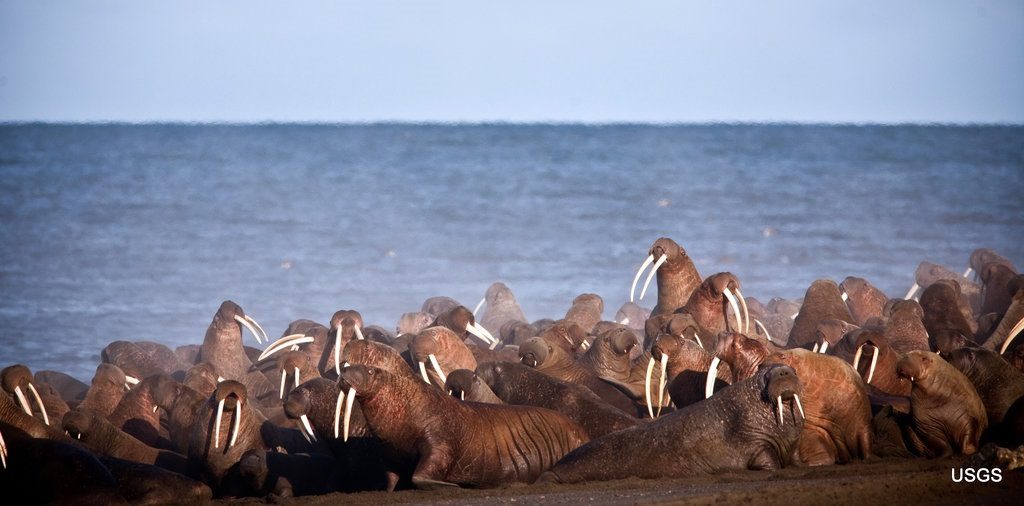Lawsuit filed after US fails to list walruses as threatened

In this September 2013 photo provided by the United States Geological Survey (USGS), walruses gather to rest on the shores of the Chukchi Sea near the coastal village of Point Lay, Alaska. A national environmental organization seeking additional protections for Pacific walrus is suing the Trump administration for failing to list the marine mammals as a threatened species. (Ryan Kingsbery/USGS via AP, File)
ANCHORAGE, Alaska — The question of whether Pacific walruses are a threatened species will be decided in federal court.
An environmental group sued the Trump administration on Thursday over its failure to list the Arctic marine mammals as threatened because of diminished sea ice — their primary habitat — brought on by climate warming.
During the Obama administration, the United States Fish and Wildlife Service concluded in 2011 that walruses deserve the additional protection of being declared threatened.
However, a final decision was delayed because agency officials said other species were a higher priority.
In October, facing a court-ordered deadline for a final decision, the agency reversed course and said it could not conclude with certainty that walruses would be affected by ice loss because they have shown an ability to forage from shoreline resting areas.
Emily Jeffers, an attorney for the Center for Biological Diversity, said walruses need sea ice for far more than foraging.
She said it is necessary “pretty much for all of their essential life functions, from mating to nursing to molting to resting.”
Walrus, in recent years, have been forced to the shores of Alaska and Russia in late summer because of a lack of sea ice. That made them vulnerable to predators and trampling of their young by other walruses spooked by airplanes, polar bears or other causes, according to Jeffers.
“Congregating on shore has a lot of costs and mortality risks,” Jeffers said. “That’s why they prefer the ice. So I think it’s kind of disingenuous for the Fish and Wildlife Service to say they can just move onto land without addressing the costs.”
A Fish and Wildlife Service spokesman referred questions on the lawsuit to the Department of Justice, which did not respond immediately to an email request for comment.
Proponents of offshore oil drilling, including the state of Alaska, oppose the endangered listing in part because it could add a layer of federal review and possible restrictions on exploration and production. They also contend that walruses are thriving.
In October, the Fish and Wildlife Service acknowledged that climate models showing the Chukchi Sea between northwest Alaska and Russia could be ice-free in summer by 2060.
However, since 2011, walruses have made due with less ice, the agency said in its decision.
“Walrus demonstrated much more ability to change their behaviors than previously thought,” said Patrick Lemons, the agency’s marine mammals management chief in Alaska.
Walruses dive to feed on clams and other bottom-dwellers. They can surpass 300 feet (92 meters) but most feeding is within 262 feet (80 meters).
Walruses spend winters in the Bering Sea. As ice melts in spring, almost all females, young walruses, and some males migrate north into the Chukchi Sea by riding on ice as it recedes north, providing constant transport to new foraging areas.
During breeding season from December to March, sea ice serves to aggregate both sexes, allowing males to compete for mates, according to the lawsuit.
Females give birth on sea ice. Calves can nurse for two years or more. Sea ice allows walruses to avoid predators and humans and provides a dry platform for nursing.
The lawsuit contends that the best available science indicates temperatures will continue to trend upward, which will lead to thinner ice that melts sooner in spring and forms later in fall.
“We’re confident the court will see this reckless finding as a politically driven decision that completely ignores the agency’s legal obligations to protect imperiled wildlife,” Jeffers said. /kga